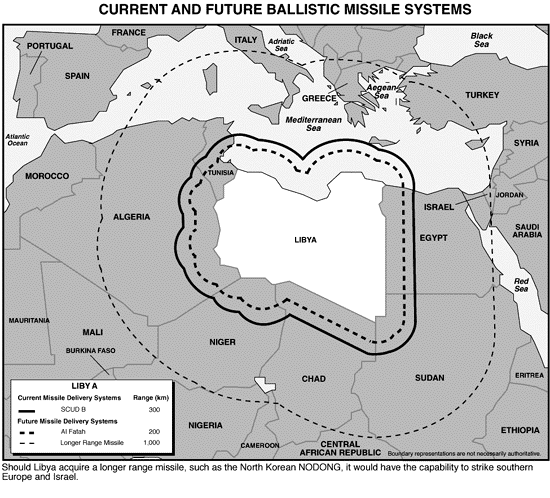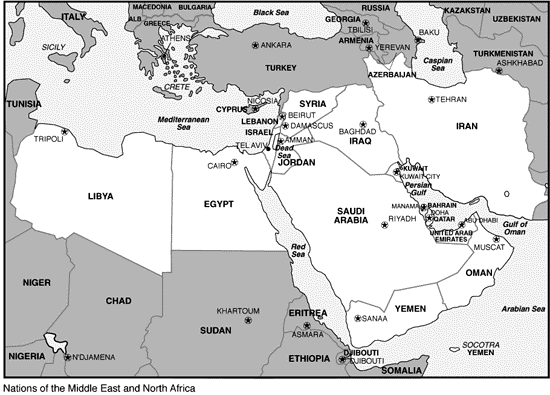

U.S. goals in the Middle East and North Africa include securing a just, lasting, and comprehensive peace between Israel and all Arab parties with which it is not yet at peace; maintaining our steadfast commitment to Israel's security and well-being; building and maintaining security arrangements that assure the stability of the Gulf region and unimpeded commercial access to its petroleum reserves, which are vital to our economic prosperity; ensuring fair access for American business to commercial opportunities in the region; combating terrorism; and promoting more open political and economic systems and respect for human rights and the rule of law. In this volatile region, the proliferation of NBC weapons and the means to deliver them poses a significant challenge to our ability to achieve these goals. Iran, Iraq, and Libya are aggressively seeking NBC weapons and missile capabilities, constituting the most pressing threats to regional stability. Iran and Iraq have demonstrated their intent to dominate the Persian Gulf and to control access to critical oil supplies.
Iran is actively attempting to acquire a full range of NBC weapons and missiles. The United States believes Iran is committed to acquiring nuclear weapons, either through indigenous development or by covertly acquiring enough fissile material to produce them. During its eight-year war with Iraq, Tehran initiated biological and chemical warfare programs, the latter in direct response to Iraq's use of chemical weapons. In addition, Iran is dedicated to expanding its ballistic missile programs.
Iraq has long had NBC warfare and missile efforts. The challenges these weapons pose in time of conflict became clear during the Persian Gulf War when U.S. and allied forces had to deal with real and potential complications posed by Iraq's arsenal of NBC weapons and missiles. Iraq entered the Gulf War with a known chemical warfare capability and a demonstrated willingness to use it (Iraq used chemical weapons against Iranian troops and its own Kurdish population during the 1980s); a known biological warfare capability; and a developing, complex nuclear weapons program (despite intense nonproliferation and export control efforts by the United States and the international community (for example, the IAEA)). During the Gulf War, Iraq attempted to weaken the cohesion and resolve of the U.S.-led coalition by using its ballistic missiles as weapons of terror against Saudi Arabia and Israel; however, Iraq did not use its SCUDs with chemical or biological warheads.
In their quests to establish regional hegemony, Iran and Iraq probably regard NBC weapons and missiles as necessary to guarantee their territorial integrity and national security. Possession of nuclear weapons would likely lead to increased intimidation of their Gulf neighbors, as well as increased willingness to confront the United States. The U.S. defense commitment, military presence, and demonstrated ability to defend U.S. and allied interests against such threats are vital to achieving our goals in the region.
Libya remains a significant proliferation concern. Libyan leader Muammar Qadhafi has shown that he is willing and capable of using chemical weapons and missiles against his enemies. Libya sees the United States as its primary external threat, owing especially to U.S. support for UN sanctions against Tripoli for its refusal to turn over suspects in the terrorist bombing of Pan Am 103. Although Libya's capabilities to use chemical agents and missiles are limited, Qadhafi could provide these weapons to states he supports and that support him in return.
Iran poses the greatest threat to the stability of the region and to U.S. interests; this will remain the case as long as UN Security Commission on Iraq is able to maintain its intrusive inspection regime in neighboring Iraq. In the past, Iran has demonstrated both the will and the ability to use NBC to advance and defend national goals. Tehran used chemical weapons and ballistic missiles with conventional warheads during the Iran-Iraq war and has fired conventionally-armed cruise missiles at U.S.-flagged oil tankers.
In August 1995, Iraq admitted to a far more extensive NBC weapons and missile program than had been previously revealed. The Iraqis divulged to UN inspectors that prior to the Gulf War they had produced large quantities of biological warfare agents, had loaded them into missiles and bombs, had begun a crash program to build a nuclear weapon, and had produced engines for SCUD missiles.
In the future, the quality, scope, and staying power of the UN inspectors and on-site monitoring and verification processes will be central in determining whether the Iraqi weapon programs are dismantled, kept in check, or eventually succeed. However, Iraq's military production capabilities (not affected by UN sanctions and monitoring), past use of chemicals and missiles, and consistent efforts to deceive UN inspectors are strong indicators that Iraq will attempt to produce NBC weapons and missiles when outside constraints are absent.
In October 1994, the Iraqis repeated their oft-demonstrated willingness to threaten military action to attain their goals when they deployed Republican Guard forces to southern Iraq, thereby threatening Kuwait and its oil fields. With reconstructed conventional forces and NBC weapons and missile capabilities, Iraq could again threaten states in the region, oil fields and facilities, U.S. forces, and key logistics facilities.
NATIONAL OBJECTIVES
Iran's primary national objectives are threefold: ensuring the survival of its Islamic government, limiting foreign influence in the Middle East, and spreading Islamic fundamentalism abroad. Tehran seeks to strengthen its political, economic, and military positions as a regional power and to reduce the influence of the West, especially the United States, in the Persian Gulf, and in the greater Middle East. In addition, Iran champions Muslim causes worldwide, supporting Islamic activism in other areas in the Middle East, Africa, and Asia. Iran's efforts to add to its military power and acquire NBC weapons and missiles support these national objectives.
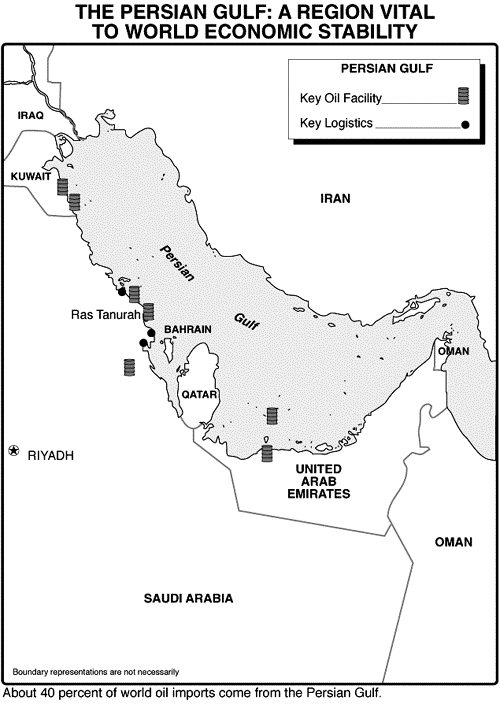
Since becoming president in 1989, Hashemi Rafsanjani has sought to win international political acceptance for Iran in order to gain European and Japanese financial assistance to rebuild Iran's economy and military forces. Although some of Iran's public rhetoric has moderated, Iran's covert actions indicate its leadership is pursuing a policy of sponsoring terrorism and assassinations of exiled Iranian dissidents, opposing Middle East peace efforts, and working to acquire and improve its NBC weapons and means of delivery.
Iran has placed a high priority on possessing NBC weapons and missiles since Tehran's defeat in the Iran-Iraq war in 1988. Iran has an adequate technological base to support chemical agent and missile production activities and a biotechnical structure capable of supporting the production of biological agents. Nevertheless, Iran is attempting to expand its current technological base to achieve self-sufficient production in all phases of NBC weapons and delivery systems. In the nuclear weapons arena, Iran is attempting to acquire an indigenous capability to produce weapons-grade fissile material. Financial constraints, supplier reluctance, and limited indigenous capabilities in certain NBC programs have slowed Iran's progress in achieving these goals.
RESOURCES
Iran continues to suffer the negative economic effects of revolution, war, and mismanagement. Foreign debt has reached about $30 billion, and Iran can afford only about $1 billion annually for military-related imports. These financial constraints affect the pace of Iran's programs for NBC weapons and missiles, even though these programs continue to have high priority.
Iran makes many of its efforts to purchase NBC weapons and missile-related technologies on the open market, and there are indications that Iranian officials stationed abroad provide clandestine support, obtaining information on foreign companies and on employees susceptible to recruitment and looking for ways to avoid relevant laws and customs procedures. In addition, Iran employs some students studying abroad to acquire technical information and identify scientific researchers who might cooperate with Iran.
STRATEGY
Expanding its NBC programs, improving means of delivery, and improving conventional military capabilities all strongly support Iranian national objectives. Iran has emphasized the acquisition of power projection capabilities -- ballistic missiles, combat aircraft, and submarines -- to oppose intervention by foreign forces during some future conflict. In order to attain self-sufficiency for its military industry, Iran purchases complete weapons and components for assembly to facilitate the flow of technology necessary for indigenous production.
NUCLEAR PROGRAM
Iran's nuclear energy program began under the Shah and included power plant development and a small research reactor purchased from the United States. The Shah also sponsored research aimed at producing fissile material for weapons development. In 1979, the country's Islamic revolution essentially halted the nuclear program, both weapons-related work and civilian nuclear activities (such as the construction of foreign-supplied power reactors). Since the end of the war with Iraq, the Islamic government has initiated civilian and weapons-related nuclear efforts, despite having signed the NPT. Of greatest concern, however, are Iran's efforts to acquire fissile material and key nuclear technology to support nuclear weapons development.
Iran has sought heavy water research reactors even though such technology has no use or value in its light water reactor-based civil nuclear power program. Iran's interest in uranium enrichment and spent fuel reprocessing, activities with no economic justification in Iran's civil nuclear energy plans, indicates Iran's desire for the capability to produce fissile materials for nuclear weapons.
China is a principal supplier of nuclear technology to Iran, and Russia may soon become another key supplier. The Iranians have purchased an electro-magnetic isotope separation unit from China. (This was one of the enrichment technologies pursued by Iraq.) China has also sold Iran a research reactor that could be used as a training model for a plutonium-producing reactor. Iran's procurement activities provide strong evidence of this.
The Iranians state that nuclear energy is required to meet their present and future energy demands. They argue for using their own oil and natural gas reserves to generate hard currency revenues, rather than wasting them on domestic consumption. At the same time, Iran's nuclear power program could be used to legitimize its attempts to acquire capabilities in sensitive phases of the nuclear fuel cycle -- such as uranium enrichment or spent fuel reprocessing -- related directly to nuclear weapons development.
At this stage, Iran's scientific and technical base remains insufficient to support major nuclear programs. The Iranians recognize their dependence on foreign assistance and are encouraging younger Iranians to study abroad to gain needed technical expertise.
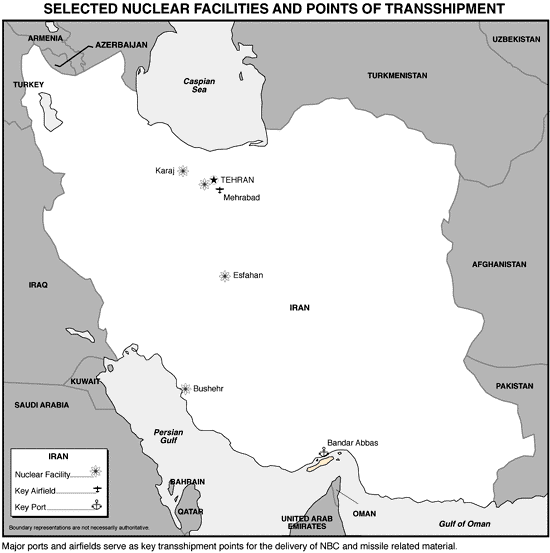
Chemical Program
Iran's offensive chemical warfare program began in 1983 in response to Iraq's use of mustard gas against Iranian troops. By 1987, Iran was able to deliver limited quantities of blister (mustard) and blood (cyanide) agents against Iraqi troops using artillery shells.
Iran has been producing chemical agents at a steadily increasing rate since 1984, and has cumulatively produced at a minimum several hundred tons of blister, blood, and choking agents. Tehran has weaponized some of these chemical agents -- a weapons stockpile to support ground combat operations. In addition, Iran could attempt to deliver chemical bombs against targets such as airfields, ports, or oil installations across the Persian Gulf.
Iran has increased defensive and offensive chemical warfare training for its ground forces in the last two years. Furthermore, it is making efforts to buy defensive chemical equipment from foreign sources, perhaps a prelude to acquiring indigenous production capability.
Although Iran has signed the CWC, its efforts to establish an independent chemical production capability and a wider program to put chemicals into battlefield weapons cast doubt on its adherence to the agreement.
Biological Program
Iran began its biological warfare program in the early 1980s during the Iran-Iraq war. It made agreements with numerous countries for cooperative research, scientific exchanges, and technology sharing. The Iranians are conducting research on toxins and organisms with biological warfare applications.
With their biotechnical support structure, the Iranians are capable of producing many different biological warfare agents. Iran has evolved from piecemeal acquisition of bioprocessing equipment and is now pursuing complete biological production plants that could be converted to producing biological warfare agents. Some of its major universities and research organizations may be linked to its biological warfare program.
BALLISTIC MISSILES
Iran first acquired SCUD-B ballistic missiles from Libya and North Korea and used them during the Iran-Iraq war. Later it received SCUD-B and SCUD-C missiles from North Korea, and CSS-8 missiles and other material from China. Iran fired nearly 100 SCUD-B missiles at Iraq from 1985 to 1988. As was the case with chemical weapons, Iran's motivation to improve and expand its ballistic missile force results from the war with Iraq, during which Iran could not respond adequately to Iraqi missile attacks on Iranian cities.
| IRAN'S BALLISTIC MISSILES | ||
|---|---|---|
| Missile Type | Estimated Range (Kilometers) | Source |
| SCUD-B | 300 | Libya and North Korea |
| SCUD-C | 500 | North Korea |
| CSS-8 (converted SA-2) | 150 | China |
Iran has a two-track ballistic missile program. In addition to acquiring SCUD missiles and missile-related equipment from North Korea, it also seeks to establish its own missile production capability. Its production program is planned for both liquid-fueled and solid-propellant missiles. As part of the process, Iran has already begun assembling missiles using foreign-made components and eventually it may produce these components domestically. Further, it is actively attempting to acquire other assistance and missile-related technology from a variety of foreign sources for its goal of producing an MRBM.
With its current inventory of missiles, Iran can strike targets in neighboring countries, including oil installations and ports in Saudi Arabia. With a longer range missile, such as the North Korean NODONG, it would be able to strike targets in Israel and in most of Saudi Arabia and Turkey.
CRUISE MISSILES AND OTHER MEANS OF DELIVERY
Iran has Chinese land-based and shipborne antiship cruise missiles and Russian air-to-surface missiles, and has experience in employing some of them in combat conditions. During the Iran-Iraq war, for example, Iran fired at least 10 coastal-based Chinese missiles at Kuwait, one hitting a U.S.-flagged oil tanker. Iran will continue to rely on China as its supplier of cruise missiles. In addition, Iran has artillery and aircraft that can deliver chemical and biological agents and Russian-made Su-24 fighter-bombers that could deliver nuclear weapons.
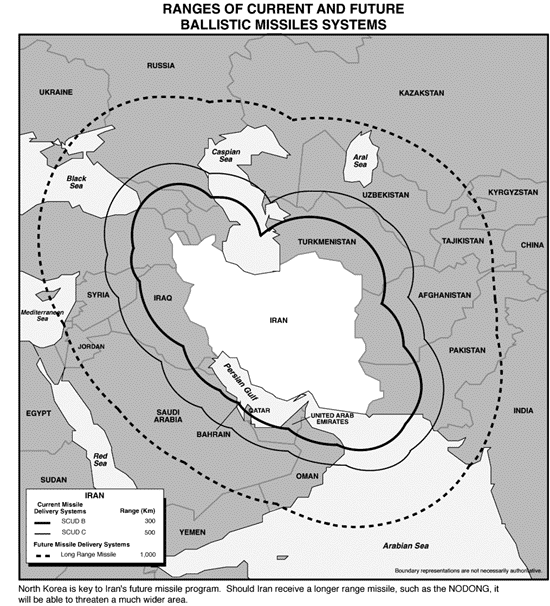
NATIONAL OBJECTIVES
Despite Iraq's defeat in the Gulf War and the severe costs to its military forces and its civilian infrastructure, Saddam Hussein's goals remain almost identical to those in effect prior to the war: to establish Iraq as the leading Arab political and military power in the Middle East and to dominate the Persian Gulf. To these ends, Saddam, or any successor with similar ambitions, will seek to rebuild Iraq's conventional military forces and reconstruct its NBC warfare and ballistic missile capability.
Historically, Iraq had developed NBC weapons and missiles programs to support Saddam's two primary goals mentioned above. Saddam has demonstrated his willingness to use chemical weapons and ballistic missiles for their tactical, strategic, and psychological value. Iraq orchestrated the development of these weapons by diverting dual-use technologies and creating extensive procurement networks with front companies. Since the end of Operation Desert Storm, the United Nations has challenged Baghdad's lack of cooperation and its noncompliance with UN Security Council Resolutions (UNSCR). Iraqi government officials have used concealment, deceit, and intimidation with the aim of eventually rebuilding their missile force and their nuclear, biological, and chemical weapons programs.
RESOURCES
Iraq's economy remains weak because of United Nations' sanctions. These sanctions, based on a number of UNSCRs, prohibit arms imports as well as most industrial imports that support the civilian sector. Iraq also is not permitted to export oil or other goods unless the proceeds are spent on food and medicine (under UN supervision), and its assets abroad remain frozen. Although industrial production has increased since the end of the war, it is only about one-third of its pre-war level. In November 1993, Iraq accepted UNSCR 715 calling for continued UN monitoring of Iraqi weapons programs; unfortunately, all indicators suggest that this acceptance does not signal Iraqi intentions to forego eventually rebuilding its NBC weapon capabilities.
STRATEGY
Prior to Operation Desert Storm, Iraq systematically misled foreign suppliers and governments regarding the actual end-users of purchases. Further, Iraq purchased controlling interests in selected Western companies to obtain legal mechanisms for placing orders for products subject to export controls. It employed middlemen and established front companies to facilitate covert acquisition activities to funnel dual-use technologies to Iraq. In addition, the Iraqi government sent numerous students to Western universities to study nuclear technology so that these individuals could eventually support Iraq's nuclear program.
Iraq has continued its deceptive efforts to keep alive elements of its NBC weapons and missile programs, as demonstrated by the August 1995 public disclosures concerning the extent of Baghdad's biological warfare effort. Another example of Iraq's noncompliance is a December 1993 incident involving the interdiction of a shipment of ammonium perchlorate -- a dual-use chemical with solid missile fuel applications. The shipment was a violation of UNSCR 715, which Iraq had already accepted.
The return of production equipment, computers, and documentation removed from key facilities prior to and during Operation Desert Storm has expedited reconstruction of military industries. Furthermore, Iraq is preserving enough of its NBC weapons programs to provide the foundation for revitalized efforts once sanctions are lifted and inspections ease or are terminated.
Iraq's large number of scientists and technicians is one of its most valuable resources for rejuvenating its programs for NBC weapons and missiles. Iraq retains the services of several thousand scientists, engineers, and technicians who were previously employed in its nuclear weapons program. With this pool of expertise, together with significant foreign assistance and supplies, Iraq could probably rebuild its nuclear weapons program and manufacture a device in about five to seven years.
NUCLEAR PROGRAM
Iraq's efforts to acquire a nuclear weapon production capability constitute a textbook case of the many avenues a country can pursue to reach this objective. To realize its nuclear weapon ambitions, Iraq established a broad, multifaceted program to produce fissile material and to develop the associated technology essential for nuclear weapon design.
Iraq began laying the groundwork for its nuclear weapons program in the 1970s, when it attempted unsuccessfully to purchase a plutonium production reactor similar to the one France used in its nuclear weapons program. In 1976, France agreed to build the Osirak and Isis reactors, part of Iraq's large nuclear research complex at Tuwaitha in Baghdad. From the late 1970s to the early 1980s, Baghdad experienced several setbacks, the most notable being the Israeli air strike on the Osirak reactor in June 1981 shortly before its first fuel was to be loaded. With the loss of this reactor, Baghdad apparently refocused its nuclear weapons effort on producing highly enriched uranium. Its interest in acquiring plutonium as fissile material for weapons continued, but at a lower priority.

Iraqi scientists concurrently investigated almost every viable uranium enrichment technique. Documents seized by IAEA inspectors in 1991 revealed a broad-based Iraqi effort to design and develop a nuclear weapon. In addition, in August 1995, the Iraqis admitted that they had established a crash program to build a nuclear weapon by April 1991.
Iraq's nuclear weapon design and development work, which was supported by at least 16 primary and supporting facilities, was severely disrupted by Operation Desert Storm. Most of the facilities were in Baghdad and the outskirts of the city, but others were in Mosul in the north and Al Qaim and Akashat in the west near the Syrian border.
The extent and sophistication of the Iraqi nuclear weapon program uncovered by UN and IAEA inspectors surprised the international community. The diversity and broad scope of the Iraqi program prompted subsequent efforts to tighten up the IAEA safeguards procedures and export controls.
Chemical Program
Since the early 1980s, Iraq has produced several thousand tons of chemical agents, primarily at its main production facility in Samarra. Other chemical warfare-related facilities were located at Al Habbaniyah. Iraq used some of its chemical weapons stockpile against the Iranians and the Kurds during the mid- to late-1980s. By the time it invaded Kuwait, Iraq probably had 1,000 metric tons of chemical agent on hand, split equally between blister agents and nerve agents. Also, it had become self-sufficient in producing many types of precursors, had produced a variety of chemical agents on its own, and had weaponized munitions with some of these agents.
| DESTRUCTION OF IRAQ'S CHEMICAL ARSENAL |
|---|
| The chief inspector of the UN Special Commission chemical destruction group said on May 11, 1994, that all known Iraqi chemical munitions, agents, and precursors had been eliminated. The group had been destroying Iraq's chemical warfare stockpile at the Samarra chemical weapons complex since June 1992. Over 27,000 chemical-filled bombs, rockets, and artillery shells had been destroyed, to include 30 SCUD chemical warheads. About 500 tons of mustard and nerve agents, and thousands of tons of precursor chemicals, were burned off or chemically neutralized. |

Iraq built its chemical program with assistance from Western sources, both individuals and companies, that supplied Iraq with vital chemical processing equipment, chemical precursors, and technical expertise. In the absence of UN monitoring or import controls, Iraq could revive a viable chemical weapon capability in a matter of months, despite war damage to its production and storage facilities. The Iraqis still have a domestic chemical industry, and converting some of these plants from producing chemicals to producing chemical warfare precursors and even agents would be relatively straightforward. Iraq retains the capability to deliver chemical agents using a variety of munitions, including artillery shells and rockets, aerial bombs, spray tanks, mortar rounds, and SCUD-type missile warheads.
Iraq's past use of chemical weapons demonstrates its willingness to ignore international norms of conduct. Iraq first used chemical agents in 1983, when Baghdad attacked Iranian military forces with mustard gas. In 1984, Iraq employed tabun-filled aerial bombs against Iran, making Iraq the first and only nation ever to have used a nerve agent on the battlefield. Iraq's successful integration of chemical weapons into offensive operations is widely accepted as one of the reasons for its victory over Iran in 1988. Baghdad used chemical weapons for their tactical and strategic value, not to mention their overwhelming psychological effect on Iranian forces. Iraq also used lethal chemical agents against its own Kurdish civilian population in 1988.
Biological Program
Iraq revealed to UN inspectors in August 1995 that it had a far more extensive and aggressive biological warfare program prior to the Gulf War than it had previously admitted. The Iraqis claim to have produced 90,000 liters of botulinum toxin and 8,300 liters of anthrax, as well as significant quantities of an agent that causes cancer. Further, the Iraqis claim to have loaded botulinum toxin and anthrax on SCUD missiles warheads and aerial bombs. Baghdad also admitted conducting research on mycotoxins and infectious viruses. The Iraqis claimed in August 1995 that they destroyed the agents after the Gulf War (January-February 1991), but have yet to produce evidence to support their claim.
Since the end of Operation Desert Storm, Iraqi declarations and UN inspections have exposed an extensive dual-use fermentation capability and additional facilities probably linked to the weapons program. Because of their dual-use nature, most equipment and procedures related to producing biological agents are rationalized as legitimate agriculture, biomedical, and biotechnical industrial activities.
Coalition air strikes destroyed or damaged many of Iraq's facilities associated with biological warfare, including those at Al Kindi and Salman Pak. However, before the Coalition operations began, the Iraqis had relocated virtually all of their agent production equipment to Al Hakam and other facilities. All known fermentation and bioproduction equipment remains intact, and key experts are still available to serve Iraq's military programs. Consequently, Iraq retains the infrastructure that previously developed and produced biological warfare agents and weapons, and could easily renew production of biological agents when intrusive UN inspections are discontinued.
BALLISTIC MISSILES
Soviet SCUD missiles were the basic building block of Iraq's missile development program. During the late 1980s, Baghdad began to enlarge the propellant tanks and reduce the SCUD warhead weight to reach targets beyond the missile's 300-kilometer maximum range. Iraq also focused on a domestic manufacturing capability for these modified SCUDs, as well as the Badr 2000, a solid-propellant missile based on the Argentine Condor, with a 750-1,000-kilometer range. Baghdad also had plans for a 2,000-kilometer range missile, called the Tammouz I. As a result, by the start of Operation Desert Storm, Iraq had in place a support structure for the eventual manufacture of liquid- and solid-propellant ballistic missiles.
The principal missile launched during Operation Desert Storm was the 600-650 kilometer SCUD variant called the Al Husayn. A variant of the Al Husayn was also produced, known as the Al Husayn Short. The Iraqis claimed to have fired another SCUD variant, the Al Hijarah, which may have had a concrete-filled warhead, at Israel during Operation Desert Storm.
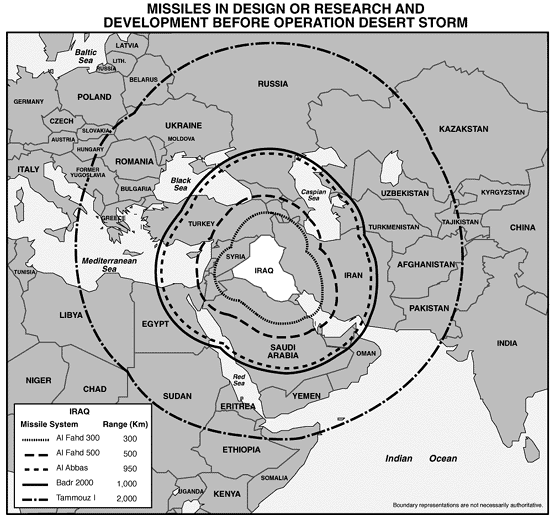
| Missile | Iraqi Declarations to the UN |
|---|---|
| Al Fahd 300 | Intended range of 300 km. Based on converting the Russian SA-2 surface-to-air missile (SAM) into a ballistic missile. Abandoned in research and development. |
| Al Fahd 500 | Intended range of 500 km. Displayed at 1989 Baghdad Arms Exposition. A mock-up for a disinformation campaign that never reached the design phase. |
| Al Abbas | Claimed range of 950 km. Longer in length and carried a lighter payload than the Al Husayn. Abandoned during research and development. |
| Badr 2000 | Intended range 750-1,000 km. Solid-propellant, 2-stage. Based on Argentine Condor missile. Facilities constructed to support missile production. Under research and development. |
| Tammouz I | Claimed range 2,000 km. Based on SCUD technology with SA-2 SAM sustainer for second stage. In design stage, but not developed further for research and development. |
| Al Abid | A 3-stage space launch vehicle. First stage consisted of 5 Al Abbas airframes. Test launch of first stage in December 1989. |
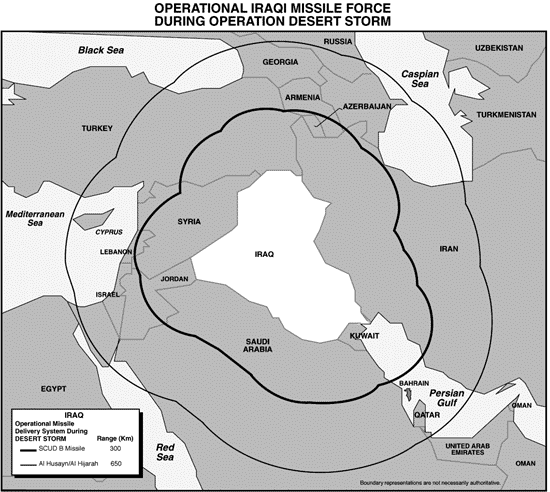
| Range (kilometers) | Number Launched | |
|---|---|---|
| SCUD-B | 300 km | 0 |
| Al Husayn | 600-650 km | 84 |
| Al Husayn-Short | 600-650 km | 3 |
| Al Hijarah | 600-650 km | 1 |
| CURRENT IRAQI SURFACE-TO-SURFACE ROCKET AND BALLISTIC MISSILE SYSTEMS PERMITTED UNDER UNSCR 687 | |||
|---|---|---|---|
| Type | Country of Origin | Range (km) | Status and Remarks |
| LUNA/FROG-7 | Russia | 70 | In service; limited potential for range extension. |
| Astros II | Brazil | 60 | In service; limited potential for range extension. |
| SA-2 (potential SSM) | Russia | Unknown | Currently widely used in Iraq as a SAM. Iraq aware of Chinese ability to convert SA-2s into surface-to-surface missiles (SSMs). |
| SA-3 (potential SSM) | Russia | Unknown | Also used widely as a SAM in Iraq. Iraq tried to convert the SA-3 to an SSM prior to the Gulf War, but failed. No evidence that the program has been revived. |
| Ababil-50 | Iraq | 50 | Entering service in limited numbers. Potential for range extension probably limited. |
| Ababil-100 | Iraq | 100-150 | In development, with parallel solid- and liquid-propellant versions being considered. Great potential for range extension. |
Even though most of Iraq's missile production facilities received heavy damage during the Gulf War, Baghdad maintains some of the equipment needed to produce ballistic missiles, in part because of the dual-use nature of much of the equipment required for producing SCUDs. Today, Iraq's production efforts are focused on developing the Ababil-100, with an estimated maximum range of 150 kilometers, and the Ababil-50, a Yugoslav-designed 50-kilometer range battlefield artillery rocket. Many of the Ababil-100 liquid-propellant missile production technologies are compatible with SCUD production.
UNSCR 687 prohibits Iraqi possession of missiles with a range greater than 150 kilometers. Nevertheless, the United States believes Iraq has hidden a small number of mobile launchers and several dozen SCUD-type missiles produced before Operation Desert Storm.
CRUISE MISSILES AND OTHER MEANS OF DELIVERY
Iraq has Chinese land-based and air-launched antiship cruise missiles. Although its stockpile is likely limited, Iraq used French air-launched and Chinese land-based and air-launched missiles during the Iran-Iraq war. Iraq enhanced its anti-ship capability by forward-deploying aircraft and by using aerial refueling to strike oil tankers in the Strait of Hormuz. Iraq still possesses a variety of other platforms capable of delivering both chemical and biological weapons, including artillery and tactical rockets, combat aircraft and helicopters.
Libya has a long history of subverting and destabilizing Arab and African nations by supporting coups, funding and training opposition forces and guerrilla groups, and plotting the assassinations of foreign leaders. Qadhafi has invaded, occupied, and/or claimed territory in all of Libya's neighbors except Egypt. He has at times supported foreign Islamic extremists, and he has frequently criticized Arab governments that have attempted to open dialogue with Israel.
Under Qadhafi's leadership, Libya remains a potential threat to the international community and neighboring states. While pursuing his political and military aspirations, he has squandered the country's oil wealth on a program for NBC weapons, missiles, and an enormous inventory of conventional military equipment. Since seizing power in 1969, Qadhafi has unsuccessfully attempted to turn the Libyan state into a regional military power.
Qadhafi has demonstrated both his desire to acquire ballistic missiles and an NBC weapon capability as well as his willingness to use the capabilities at his disposal. In 1987, when his military operation against Chad was nearing defeat, Qadhafi ordered his forces to use chemical agents against Chadian troops. In response to U.S. retaliatory strikes for the terrorist bombing of a Berlin discotheque, Qadhafi fired SCUD missiles at the Italian island of Lampedusa. Although the SCUD missiles did not cause significant damage, the act constituted a symbolic gesture of defiance directed at the United States and the international community. Finally, and more importantly, Qadhafi has ordered kidnappings and both supported and employed international terrorism against Western nations.
NATIONAL OBJECTIVES
Qadhafi, who remains largely unchallenged as Libya's leader, controls nearly all policy decisions for his country. His aim is to enhance Libya's military strength and power projection capability, in part by possessing NBC weapons and missiles. Qadhafi apparently believes these efforts promote Libya's status as a regional military power, enhance national prestige, and provide Libya limited strategic military capabilities.
RESOURCES
Libya probably dedicates several hundred million dollars annually to acquire NBC weapons and missiles, made possible by its substantial income from oil and natural gas exports. However, since it does not have the ability to produce these weapons on its own, Libya will continue to rely heavily on foreign technical assistance.
STRATEGY
Qadhafi's efforts to become a recognized military power in the region have been generally unsuccessful. Despite accumulating a large military inventory, Libya has failed to develop its conventional military capabilities, as evidenced by its embarrassment at the hands of Chadian forces in the 1980s.
Even though Qadhafi has been successful in holding on to power in Libya, he has not become a regional leader. His numerous schemes to form political unions with other Arab states have failed, and his support of insurgent and opposition movements has done little to enhance Libya's standing or further its policy agenda. Qadhafi's continued support for terrorism has resulted in an extended confrontation with the United States and, more recently, has prompted United Nations sanctions.
As a result of these setbacks, Qadhafi has placed greater emphasis on a more dangerous strategy: developing NBC weapons and missiles. Qadhafi views these weapons as critical in his drive to establish himself as the leader of the Arab world. In addition, he hopes that ongoing efforts to develop and ultimately produce NBC weapons, especially nuclear weapons, will give his nation prestige among Islamic and other Third World nations, recognition he has sought for three decades.
NUCLEAR PROGRAM
Qadhafi's long-standing desire to acquire a nuclear weapon is well-known. Nonetheless, despite concerted efforts, Libya's program to establish an independent nuclear research and fuel cycle capability remains in its early stages. Despite Libya's public pronouncements of its peaceful intent, the underlying motivation behind this program continues to be acquiring nuclear weapons.
Libya deposited its instruments of ratification to the NPT in 1975 and its declared facilities are under IAEA full scope safeguards. Libya's rudimentary nuclear program includes a small research reactor, provided by the Soviet Union in the mid-1970s, at the Tajura nuclear research center near Tripoli. Waning commitments by Russia to provide assistance to operate and maintain the center have diminished activities at the site. To compensate, and to build up its indigenous resources, Libya continues to send scientists abroad for training and actively recruits foreign nuclear scientists and technicians. However, Libya's program lacks well-developed plans, technical expertise, consistent financial support, and sufficient support from foreign suppliers.
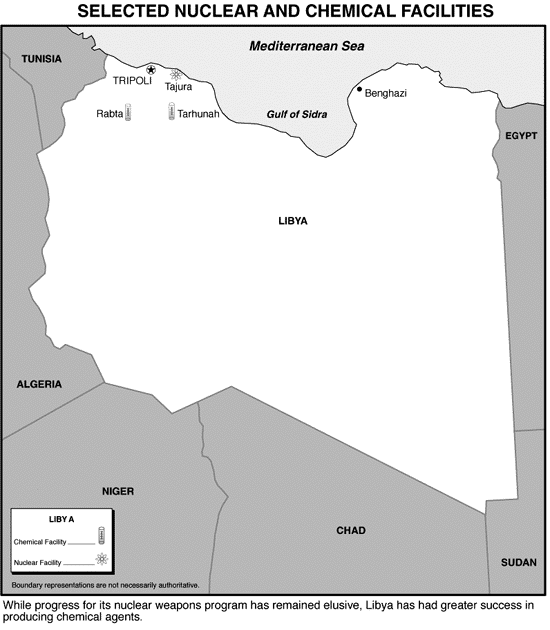
CHEMICAL PROGRAM
Libya is one of few nations in the last decade to have employed chemical weapons, having dropped chemical agents from a transport aircraft against Chadian troops in 1987. Iran supplied the agents in exchange for naval mines.
In addition, Tripoli has looked to establish an indigenous chemical warfare program, and in late 1988, with extensive foreign assistance, completed construction of the Rabta chemical agent facility. During three years of operation, at least 100 metric tons of blister and nerve agents were produced at this facility. When the United States brought Libya's chemical warfare program to the attention of the international media in 1988, Libya responded in 1990 by fabricating a fire to make the Rabta facility appear to have been seriously damaged.
Although the Rabta facility appears inactive, Libya's chemical weapons program continues to flourish. To replace the Rabta facility, Libya has begun constructing a large, underground chemical warfare plant near Tarhunah, a mountainous region about 60 kilometers southeast of Tripoli. Putting the facility underground masks its activities and increases its survivability in case of an attack. In the meantime, Libya will rely on foreign sources for its precursor needs. Libya claims it will not sign the CWC as long as other countries in the region possess NBC weapons. Libya almost certainly will keep its chemical warfare program as long as Qadhafi remains in power.
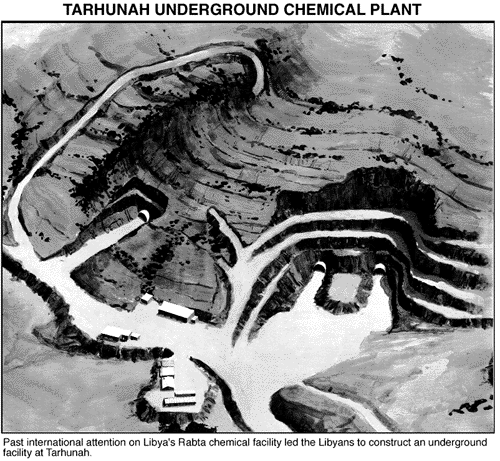
BIOLOGICAL PROGRAM
Libya continues its efforts to establish a biological warfare capability. However, hampered by its inadequate biotechnical foundation, the Libyan offensive biological warfare program remains in the early research and development stage. Libya may look to small research and development programs supported by universities to fill in the gaps in its technical knowledge. These technical shortcomings, combined with limitations in Libya's overall ability to put agents into deliverable munitions, will preclude production of militarily effective biological warfare systems for the foreseeable future.
BALLISTIC MISSILES
Libya's only operational ballistic missile system is the SCUD-B, acquired from the former Soviet Union in the mid-1970s. The acquisition of an extended-range missile, such as the North Korean NODONG, and the development of an indigenous missile -- designed to reach 1,000 km -- would give Libya the capability to reach regional adversaries.
International constraints make purchasing a longer range missile, such as North Korea's NODONG, difficult. In addition, developing an indigenous ballistic missile production program also requires extensive foreign assistance. So far, Libya's program has made slow progress in its 13-year history, and has succeeded only in manufacturing liquid-fueled rockets with an approximate range of 200 kilometers. However, despite this lack of dramatic gain, the program continues to receive government support.
In addition to its liquid-fueled rocket program, Libya also may pursue testing and production of solid-propellant tactical rockets and missiles. Although UN sanctions have impeded its ability to obtain the technologies it needs for these programs, Libya continues its research and development efforts aimed at acquiring ballistic missiles.
CRUISE MISSILES AND OTHER MEANS OF DELIVERY
Libya has Soviet-made shipborne and European-made land-based and shipborne anti-ship cruise missiles. Libya has artillery and tactical rockets, as well as several aircraft that could deliver chemical agents, including MiG-23, Su-22, and Su-24 fighters; Tu-22 bombers; Mi-2 and Mi-8 helicopters; and AN-26 transports.
